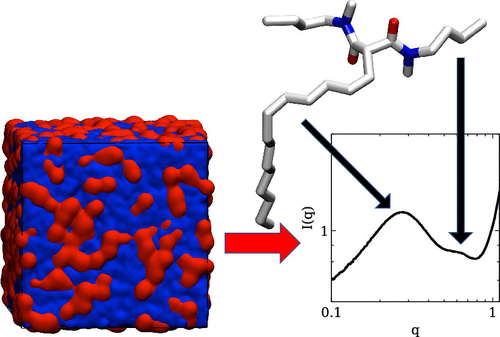当前位置:
X-MOL 学术
›
J. Phys. Chem. B
›
论文详情
Our official English website, www.x-mol.net, welcomes your feedback! (Note: you will need to create a separate account there.)
Amphiphile Organization in Organic Solutions: An Alternative Explanation for Small-Angle X-ray Scattering Features in Malonamide/Alkane Mixtures
The Journal of Physical Chemistry B ( IF 3.3 ) Pub Date : 2020-11-17 , DOI: 10.1021/acs.jpcb.0c07080 Michael J. Servis 1 , Marek Piechowicz 2 , Ilya A. Shkrob 2 , L. Soderholm 2 , Aurora E. Clark 1, 3, 4
The Journal of Physical Chemistry B ( IF 3.3 ) Pub Date : 2020-11-17 , DOI: 10.1021/acs.jpcb.0c07080 Michael J. Servis 1 , Marek Piechowicz 2 , Ilya A. Shkrob 2 , L. Soderholm 2 , Aurora E. Clark 1, 3, 4
Affiliation

|
The role of different intermolecular interactions in the aggregation of amphiphiles in an organic solvent is studied for systems of relevance to liquid–liquid extraction (LLE), a chemical process used to selectively recover metals from complex mixtures. Of specific interest is the role, or lack thereof, of hydrogen bonding, which is often assumed to be a main driver of the organic phase structural organization that has been linked to separation efficacy. Toward that end, a series of malonamide extractants in n-dodecane have been studied in the absence of any extracted aqueous solutes, including water. The series of extractants includes N,N′-dimethyl-N,N′-dibutyltetradecylmalonamide (DMDBTDMA), two of its homologs, and N,N′-dimethyl-N,N′-dioctylhexylethoxymalonamide (DMDOHEMA). This simplified model LLE system enables systematic investigation of the role of dipole–dipole and alkyl tail steric interactions in amphiphile aggregation. Small-angle X-ray scattering (SAXS) profiles computed from molecular dynamics trajectories are in good agreement with experimental SAXS data. Molecular dynamics simulations show that malonamide aggregation results from dipole-driven self-association and lacks characteristic aggregate sizes. Mid-q correlation peaks in the SAXS profiles emerge at high concentration for each malonamide. In those densely packed solutions, the correlation peaks are observed to result from alkyl tail-induced spacing between electron-rich polar head groups, with peak positions determined by the different alkyl tail lengths present in the malonamide molecule. This explanation of the SAXS correlation peaks contrasts with the prevailing literature, which attributes mesoscale features observed in small-angle scattering to the formation of microemulsions. Instead, this work finds that these features are present in the absence of water or any reverse micellar organization of the malonamides. As such, molecular-scale malonamide self-association and packing, rather than microemulsion-based colloidal-scale descriptions, is a more appropriate framework for these LLE systems.
中文翻译:

有机溶液中的两亲组织:丙二酰胺/烷烃混合物中小角X射线散射特征的另一种解释
对于与液-液萃取(LLE)相关的系统,研究了分子间相互作用在两亲物聚集中的作用,该系统是一种用于从复杂混合物中选择性回收金属的化学过程。特别令人感兴趣的是氢键的作用或缺乏氢键,氢键通常被认为是有机相结构组织的主要驱动力,而有机相结构组织已与分离效果相关。为此,在不存在任何萃取的含水溶质,包括水的情况下,研究了在正十二烷中的一系列丙二酰胺萃取剂。一系列萃取剂包括N,N'-二甲基-N,N′-二丁基十四烷基丙二酰胺(DMDBTDMA),其两个同源物,和N,N′-二甲基-N,N′-二辛基己基乙氧基丙二酰胺(DMDOHEMA)。这个简化的模型LLE系统能够系统地研究偶极-偶极和烷基尾空间相互作用在两亲物聚集中的作用。根据分子动力学轨迹计算的小角X射线散射(SAXS)轮廓与实验SAXS数据非常吻合。分子动力学模拟表明丙二酰胺聚集是由偶极驱动的自缔合产生的,并且缺乏特征性的聚集体尺寸。中q对于每种丙二酰胺,SAXS谱中的相关峰均以高浓度出现。在那些密集堆积的溶液中,观察到相关峰是由富电子极性头基团之间的烷基尾部诱导的间距产生的,其峰位置由丙二酰胺分子中存在的不同烷基尾部长度确定。SAXS相关峰的这种解释与主流文献相反,后者将在小角度散射中观察到的中尺度特征归因于微乳液的形成。相反,这项工作发现在没有水或丙二酰胺的任何反胶束组织的情况下都存在这些特征。因此,分子级丙二酰胺的自缔合和堆积,而不是基于微乳液的胶体级描述,
更新日期:2020-11-25
中文翻译:

有机溶液中的两亲组织:丙二酰胺/烷烃混合物中小角X射线散射特征的另一种解释
对于与液-液萃取(LLE)相关的系统,研究了分子间相互作用在两亲物聚集中的作用,该系统是一种用于从复杂混合物中选择性回收金属的化学过程。特别令人感兴趣的是氢键的作用或缺乏氢键,氢键通常被认为是有机相结构组织的主要驱动力,而有机相结构组织已与分离效果相关。为此,在不存在任何萃取的含水溶质,包括水的情况下,研究了在正十二烷中的一系列丙二酰胺萃取剂。一系列萃取剂包括N,N'-二甲基-N,N′-二丁基十四烷基丙二酰胺(DMDBTDMA),其两个同源物,和N,N′-二甲基-N,N′-二辛基己基乙氧基丙二酰胺(DMDOHEMA)。这个简化的模型LLE系统能够系统地研究偶极-偶极和烷基尾空间相互作用在两亲物聚集中的作用。根据分子动力学轨迹计算的小角X射线散射(SAXS)轮廓与实验SAXS数据非常吻合。分子动力学模拟表明丙二酰胺聚集是由偶极驱动的自缔合产生的,并且缺乏特征性的聚集体尺寸。中q对于每种丙二酰胺,SAXS谱中的相关峰均以高浓度出现。在那些密集堆积的溶液中,观察到相关峰是由富电子极性头基团之间的烷基尾部诱导的间距产生的,其峰位置由丙二酰胺分子中存在的不同烷基尾部长度确定。SAXS相关峰的这种解释与主流文献相反,后者将在小角度散射中观察到的中尺度特征归因于微乳液的形成。相反,这项工作发现在没有水或丙二酰胺的任何反胶束组织的情况下都存在这些特征。因此,分子级丙二酰胺的自缔合和堆积,而不是基于微乳液的胶体级描述,



























 京公网安备 11010802027423号
京公网安备 11010802027423号